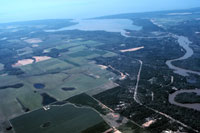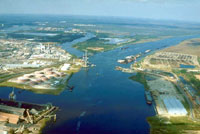• Climate in the Gulf • The Report • For Teachers • Overview • Slow the Change • Speed our Response • Overview • Water Resources • Sea Level Change • Human Perspectives |
Alabama
Alabama's current population is almost 4.5 million and is projected to increase to about 5.2 million in 2025. The state's freshwater resources will be increasingly tapped for urban residential or industrial uses, irrigation, the prevention of saltwater intrusion in coastal aquifers, and the maintenance of healthy aquatic ecosystems. Competing demands on limited water resources due to population and economic growth will increase freshwater management challenges with or without climate change. However, climate change would cause additional stress to the situation. Any change in rainfall, evaporation, groundwater recharge rates, and runoff patterns would affect ecosystems and all users of fresh water. For example:
More on Alabama: Introduction | Climate Projections | Human Health | Agriculture & Forestry | Freshwater Resources | Biodiversity & Land Conservation | Fisheries | Coastal Development | AL Resources & Links Photo Credits: Alabama Canebrake pitcher plant - Threatened & Endangered Species of Alabama. R. Johnson & B. Wehrle; www.pfmt.org. Fish River - NOAA Photo Library. Mobil River and harbor - U.S. Army Corps of Engineers, G. Edwards. |
• Overview • Alabama • Florida • Louisiana • Mississippi • Texas • Overview • Apalachicola Bay • Big Thicket • Everglades • Laguna Madre • Mississippi Delta | |||


 More extreme rainfall events, a trend already detected, create their own challenges: extreme runoff can produce overload on the sewage systems with resulting septic contamination of surface and coastal waters, and negative consequences for health and the fishing industry.
More extreme rainfall events, a trend already detected, create their own challenges: extreme runoff can produce overload on the sewage systems with resulting septic contamination of surface and coastal waters, and negative consequences for health and the fishing industry. Where saltwater intrudes into coastal groundwater sources due to sea-level rise, freshwater resources could be further affected. Baldwin and Mobile counties (Mobile Bay and Gulf Shores), for example, are already experiencing higher salinity levels in wells. Where saltwater intrudes into freshwater marshes, vegetation with low salt tolerance would be decimated.
Where saltwater intrudes into coastal groundwater sources due to sea-level rise, freshwater resources could be further affected. Baldwin and Mobile counties (Mobile Bay and Gulf Shores), for example, are already experiencing higher salinity levels in wells. Where saltwater intrudes into freshwater marshes, vegetation with low salt tolerance would be decimated.